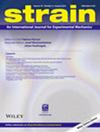Monitoring structural scale composite specimens in a post‐buckling regime: The integrated finite element stereo digital image correlation approach with geometrically non‐linear regularization
IF 1.8
3区 材料科学
Q2 MATERIALS SCIENCE, CHARACTERIZATION & TESTING
引用次数: 0
Abstract
Even though the simulations used to describe the failure of laminates are becoming more and more predictive, complex testing under multiaxial loadings is still required to validate the design of structural parts in a wide range of industrial domains. It is thus essential to assess the actual boundary conditions to allow for an objective comparison between testing and calculations, in particular since the structural tests are complex and often leads to buckling. Therefore, accurate estimation of force and moment fluxes applied to the specimen is critical. In this context, stereo digital image correlation (SDIC) has proven to be an important measurement tool and provides very well‐resolved surface displacement fields, but the exploitation of such measurements to calculate fluxes remains problematic when testing composites. The first objective of this study is both to reduce the uncertainty associated with fluxes determination on a complex test and to simplify the extraction process with respect to existing procedures. The second objective is to make this methodology robust to geometrically non‐linear deformations. In this paper, we propose a new methodology that extracts minimal boundary conditions in the form of 3D mechanically admissible displacements fields. The approach developed uses a finite element SDIC (FE‐SDIC) method regularized by means of mechanical behaviour admissibility equations. Results show that the new methodology outputs much more accurate fluxes than classical data generated from multiple differentiations of the displacement fields. Excellent noise robustness is obtained and quantified. Numerical predictions have been satisfactorily compared with experimental data from one structural‐scale composite specimen under complex testing.在后屈曲状态下监测结构尺度的复合材料试件:具有几何非线性正则化的集成有限元立体数字图像相关方法
尽管用于描述层压板失效的模拟越来越具有预测性,但在广泛的工业领域中,仍然需要在多轴载荷下进行复杂的测试来验证结构零件的设计。因此,必须评估实际边界条件,以便在测试和计算之间进行客观比较,特别是因为结构测试很复杂,经常会导致屈曲。因此,准确估计施加在试样上的力和力矩通量至关重要。在这种情况下,立体数字图像相关(SDIC)已被证明是一种重要的测量工具,并提供了分辨率很高的表面位移场,但在测试复合材料时,利用这种测量来计算通量仍然存在问题。本研究的第一个目标是降低复杂测试中通量测定的不确定性,并简化现有程序的提取过程。第二个目标是使该方法对几何非线性变形具有鲁棒性。在本文中,我们提出了一种新的方法,以三维机械容许位移场的形式提取最小边界条件。所开发的方法使用了有限元SDIC(FE‐SDIC)方法,该方法通过力学行为容许方程进行了正则化。结果表明,新方法输出的通量比由位移场的多次微分产生的经典数据准确得多。获得并量化了优异的噪声鲁棒性。数值预测与一个结构尺度复合材料试件在复杂测试下的实验数据进行了令人满意的比较。
本文章由计算机程序翻译,如有差异,请以英文原文为准。
求助全文
约1分钟内获得全文
求助全文
来源期刊

Strain
工程技术-材料科学:表征与测试
CiteScore
4.10
自引率
4.80%
发文量
27
期刊介绍:
Strain is an international journal that contains contributions from leading-edge research on the measurement of the mechanical behaviour of structures and systems. Strain only accepts contributions with sufficient novelty in the design, implementation, and/or validation of experimental methodologies to characterize materials, structures, and systems; i.e. contributions that are limited to the application of established methodologies are outside of the scope of the journal. The journal includes papers from all engineering disciplines that deal with material behaviour and degradation under load, structural design and measurement techniques. Although the thrust of the journal is experimental, numerical simulations and validation are included in the coverage.
Strain welcomes papers that deal with novel work in the following areas:
experimental techniques
non-destructive evaluation techniques
numerical analysis, simulation and validation
residual stress measurement techniques
design of composite structures and components
impact behaviour of materials and structures
signal and image processing
transducer and sensor design
structural health monitoring
biomechanics
extreme environment
micro- and nano-scale testing method.
 求助内容:
求助内容: 应助结果提醒方式:
应助结果提醒方式:


